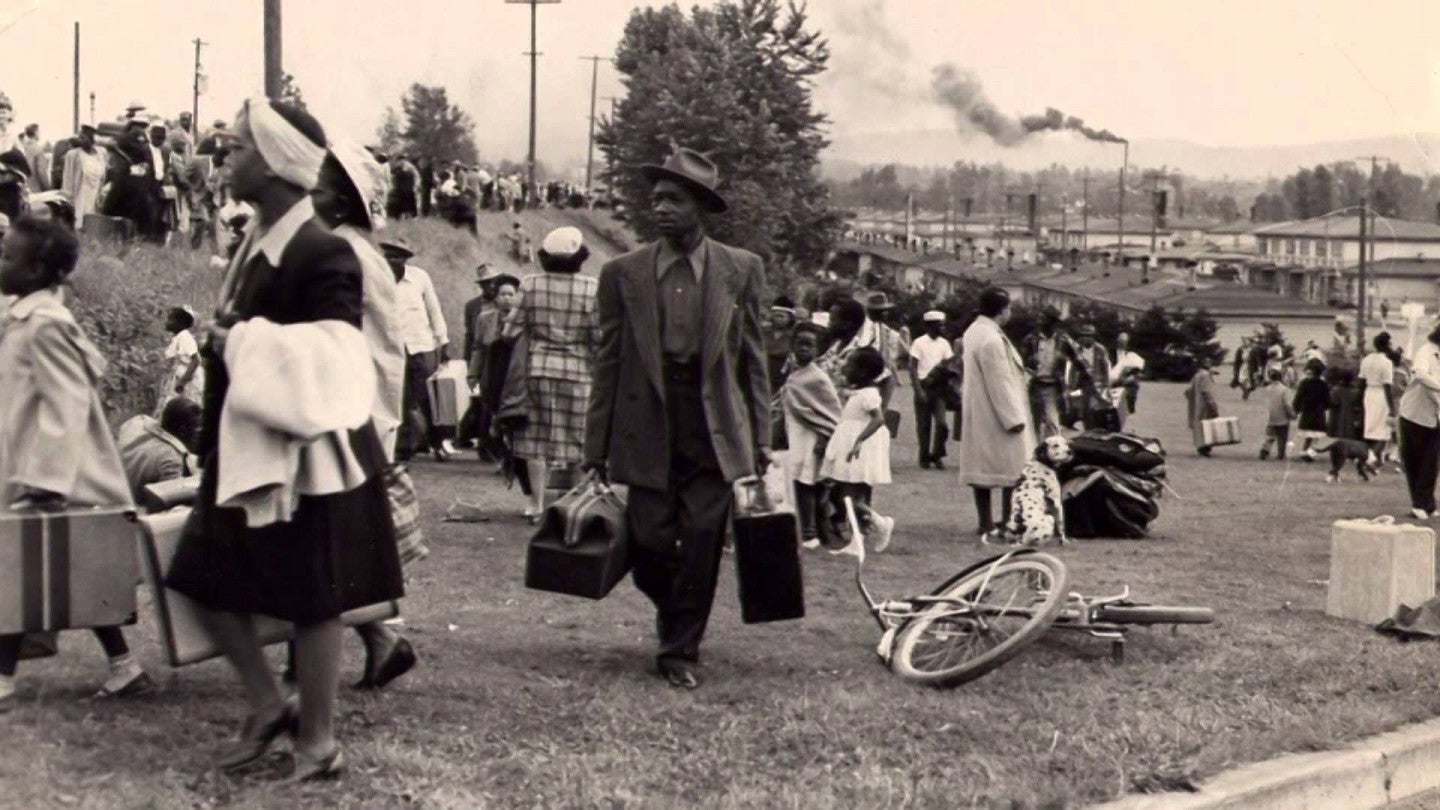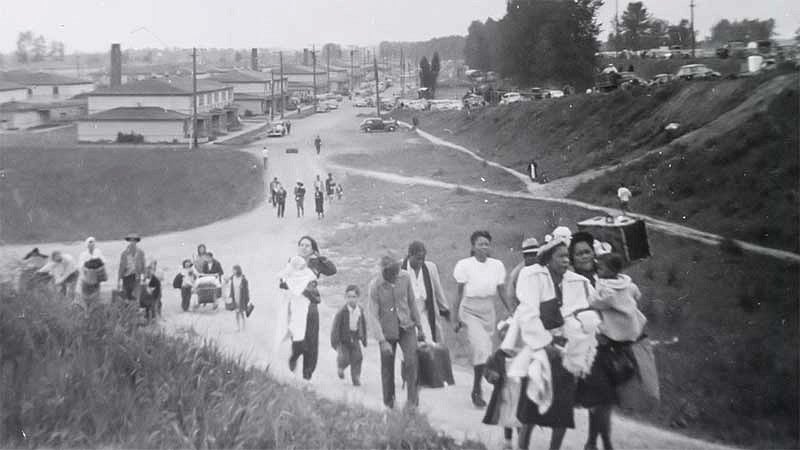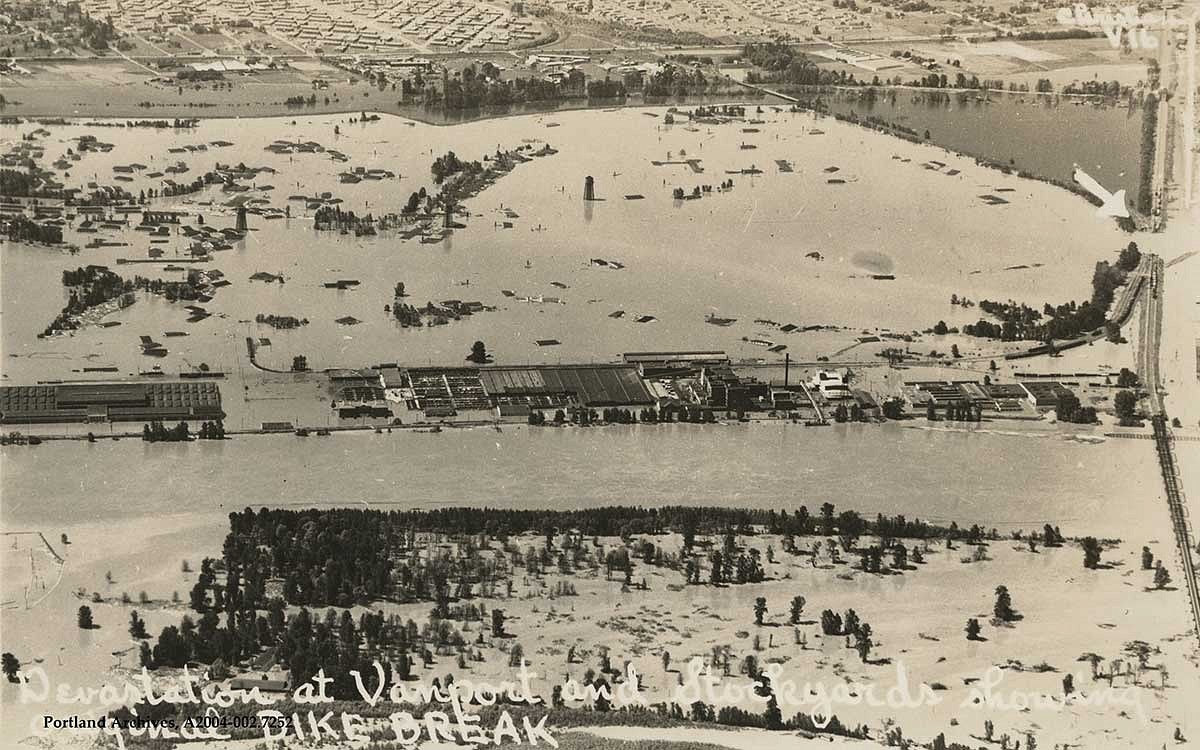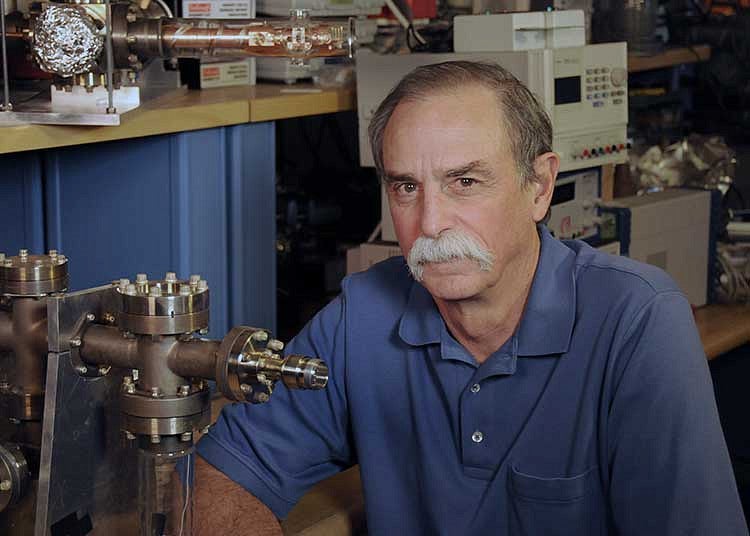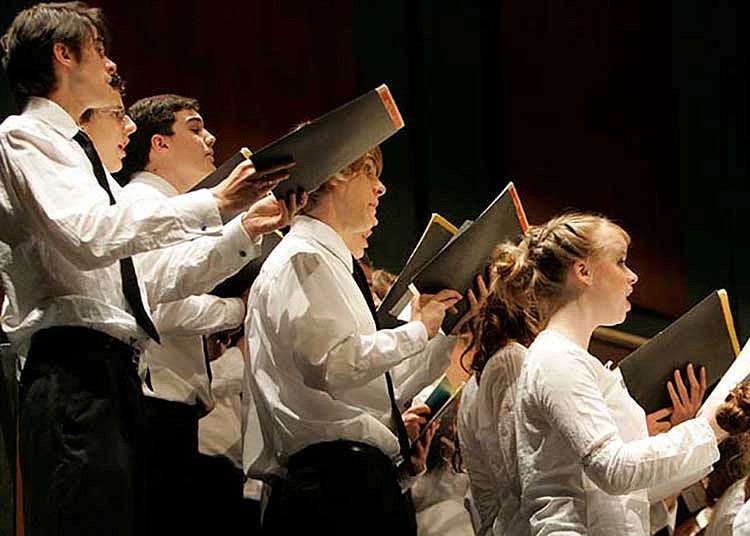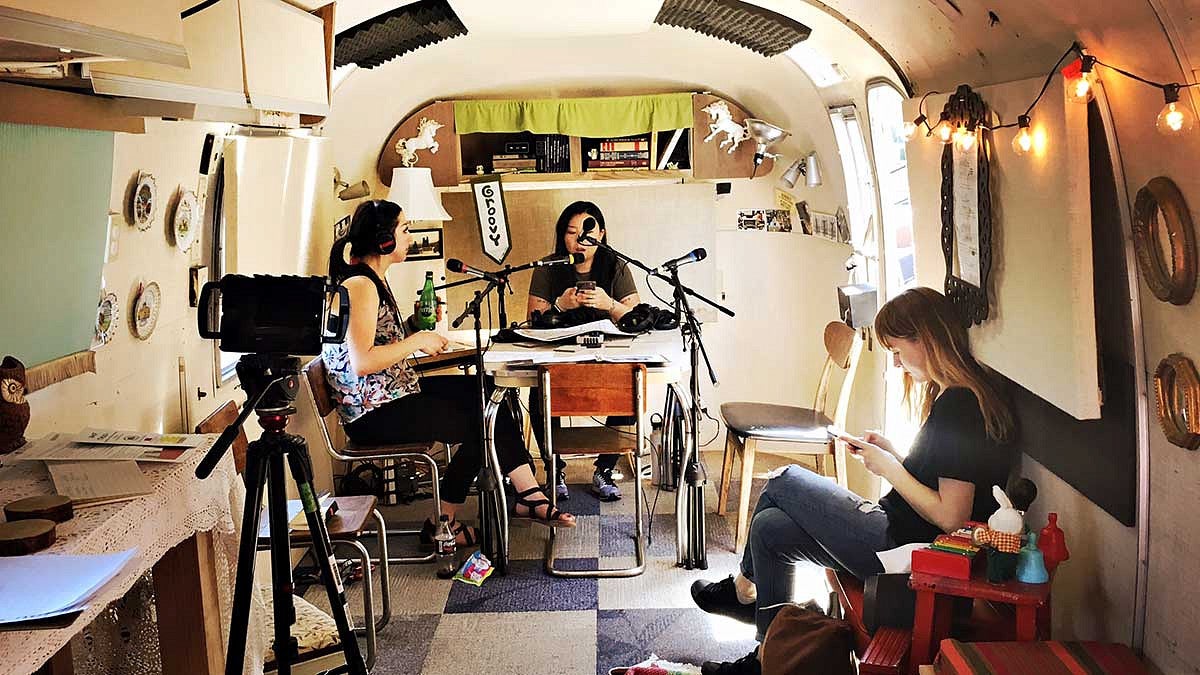
Resurfacing History
Resurfacing History
Resurfacing History
STORY AND VIDEO BY LAURIE NOTARO
PHOTOS COURTESY OF LAURIE NOTARO, ANDREW DeVIGAL AND THE CITY OF PORTLAND ARCHIVES
In 1948, six-year-old Hurtis Hadley was flying a kite on a Memorial Day weekend when the water came.
Hadley, now 74, recalls that day as he leans into a microphone on a table cluttered with sound equalizers, cords and newspaper articles.
At that Formica table in the bow of a small restored a '67 Airstream trailer converted into a recording studio, three journalism graduate students listen. It is another Memorial Day weekend 69 years later, and inside, the air is still and hot, stagnant as the temperature continues to rise.
Winnie Huang, Whitney Gomes and Viktoria Haiboniuk are three of nine students from the School of Journalism and Communication’s multimedia program and five from the Historic Preservation Program that are preserving oral histories in what is called a “story harvest.” The term “story harvest” was coined by Laura Lo Forti, the co-founder of Vanport Mosaic, a three-day festival that celebrates the history of the ill-fated town and also Albina, a neighborhood in north Portland. Vanport has already vanished, and the fabric of Albina, the neighborhood where most of the survivors from Vanport settled, is experiencing the pull of gentrification.

Once the deluge arrived in Vanport, the second largest city in Oregon during World War II, Hadley says, it swallowed the town not in a gulp, but in a creeping, uniform sweep.
It took one hour for the burg, with a population of 17,000 — one-third of it black, to completely disappear, leaving a reported 13 people dead and thousands homeless.
Part of a class in multimedia journalism, the students are about to delve first-hand into what cannot be taught in a lecture; this type of journalism has to be learned and experienced. The opportunity is unique and important, evident on the faces of all three students, who will be in the Airstream for most of the festival, collecting histories. Haiboniuk furrows her brow as she tests the sound levels; Huang is focused on writing notes and questions; and Gomes studies a map of Vanport as Hadley unravels his story.
The fan at the rear of the trailer is off; it must be as silent as possible, no collateral noise from any source is allowed. Hadley, sitting very upright in a chair, recalls the moment when the water began seeping in.
He was playing along the edge of town in a field, Hadley says, speaking softly and with a rhythm that is patient and complete. He was right beneath the railroad embankment that served as a dike to restrain the Columbia River and also acted as boundary along with the Willamette River and Smith Lake, which were all swollen with an abundance of recent rain.
The Army Corps of Engineers had assured the Housing Authority of Portland that the dikes would hold; there was no need to worry. A flyer was delivered that morning to residents that directed:
REMEMBER.
DIKES ARE SAFE AT PRESENT.
YOU WILL BE WARNED IF NECESSARY.
YOU WILL HAVE TIME TO LEAVE.
DON’T GET EXCITED.
But that afternoon, Hadley says, a Southern Pacific train thundered across the tracks above the dike with enough resonance to shift the embankment, allowing the Columbia River to rush in. Minutes later, at 4:20 p.m., the six-year-old boy was running home to tell his mother that the water was on its way.
The graduate students in the Airstream are practicing community engagement, one of the innovative approaches of reporting and engaging with the community that the Agora Journalism Center is a national leader of.
“The Agora Journalism Center works first and foremost on engaged journalism,” explained Regina Lawrence, executive director of the center. “It’s about collaborative listening, getting journalists out from behind their desks and their laptops and telephones and getting them into communities to really listen in a new way. It’s about letting community voices lead journalists to what the story is, not just provide a few soundbites for a story the journalist has already decided to tell.”
This story harvest is one such innovative project. Hadley’s narrative is just one that the graduate students are capturing as part of a class shepherded by Andrew DeVigal, chair of Journalism Innovation and Civic Engagement and the first professor of practice in the SOJC.
“This is the first time I worked with a class to harvest stories with the community under these conditions,” DeVigal said, adding that the school of journalism has been working with Vanport Mosaic for several years to produce oral histories from survivors. “Many of these stories in the past have been screened at the festival.”
But the journalism school isn’t the only one represented at the story harvest; historic preservations graduate students from UO are also taking part, which provides on-the-ground experience in data collecting and researching historically significant areas.
Historic preservation chair and professor Jim Buckley found the opportunity was a rich exchange between the programs. “Our students said ‘we don’t know how to interview’ and the J-school students said ‘we don’t know much about the neighborhood history,’” he says. “They learned from each other in doing the project. That’s the kind of interaction that is possible with the concentration of professional programs we have on the U of O Portland campus.”
“Story Harvest” Interviews

Hurtis Hadley
By Viktoria Haiboniuk for Vanport Mosaic - Transcript
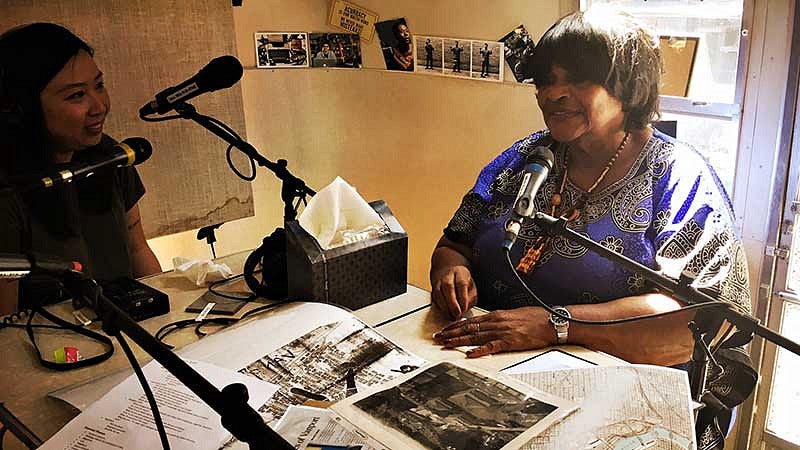
Mariah Taylor
By Whitney Gomes for Vanport Mosaic - Transcript
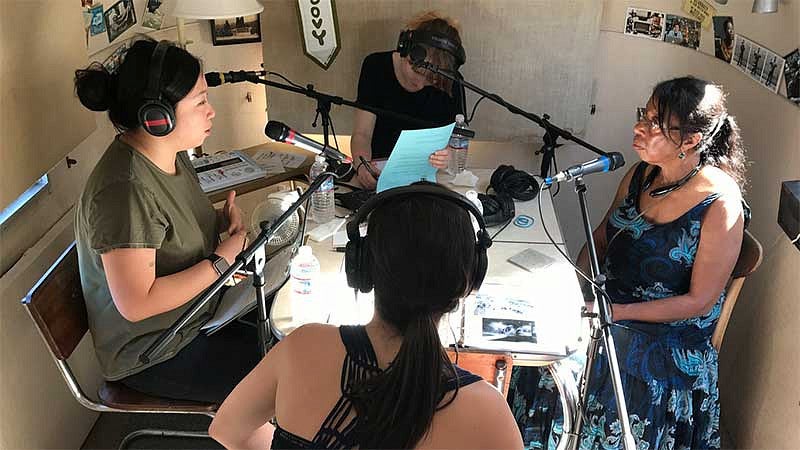
Shirley Minor
By Winnie Huang for Vanport Mosaic - Transcript
The historical aspect of Vanport and its connection to Albina should be well known, but it has somehow found itself settled in between folds of time, a lost tragedy barely remembered by those who weren’t there. With the story harvest and Vanport Mosaic, there is hope that might change.
When the second world war came with a never-ending appetite for ships, shipyard owner Henry J. Kaiser supplied the demand and built Vanport to house shipyard workers; it took three days to erect 700 pre-fabricated apartments.
At the end of the war, 10,000 of the original black residents remained in Vanport, due to discriminatory housing practices in Portland. The Housing Authority of Portland wanted to dismantle the ersatz town, but it was argued that 17,000 people couldn’t be thrown out onto the street.
But then the water came.
“Do you remember that day?” Haiboniuk asks Hadley, referring to the flood.
He nods, and waits a moment before he starts. “I ran into the house and I told my mother that the water’s coming,” he says. Haiboniuk listens through the headphones while taking sporadic notes, careful not to disturb organic progression of Hadley’s narrative. “My mother flagged down the first car going up the hill to get out of the way of the water. By the time we got up on top of the elevation, you could see the houses and stuff crumbling down.”
Mariah Taylor's Story
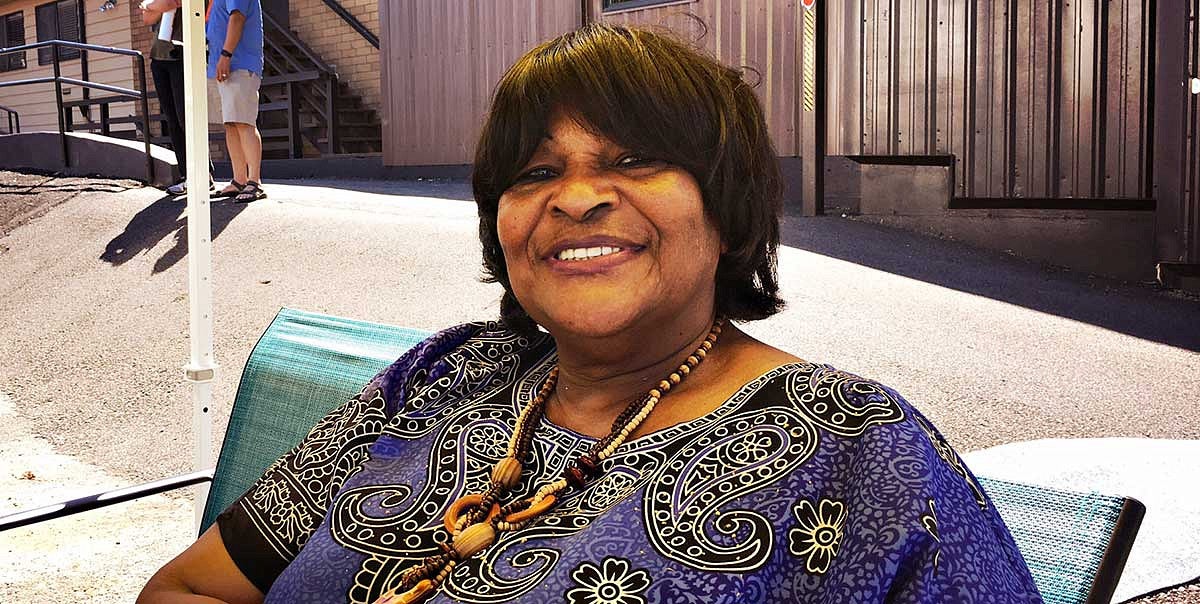
Mariah Taylor sits up in the chair, adjusts her vibrantly colored blouse, and leans into the microphone. “I am one of 25 children,” she begins. “My parents were sharecroppers in Atlanta, Texas. I came at the age of eight in 1947, lived on Denver Avenue. In Vanport.”
The retired pediatric nurse practitioner, now 77, recalls bits and pieces of her Vanport childhood and the neighborhood of Albina, where her family relocated after the flood and where Taylor still resides. Recently, the neighborhood has experienced significant changes.
“Now I see gentrification,” Taylor says in the Airstream as perspiration gathers on the brows on everyone in it. “I don’t see a thriving community or the sense of togetherness that we had. We had landmarks that are now gone. And I can’t believe the people that have never heard of Vanport.”
Which is precisely the reason that she is here. To get it down, to make a record of history that Albina existed and the strong community ties that held its residents together for decades.
“I had no idea what to expect when I met Mariah Taylor,” said Gomes, a native Portlander and multimedia graduate student who had never heard of Vanport prior to the class. “She frequently mentioned the lack of togetherness and community in the Albina area today. After the hearing her story, I better understood that the gentrification of Portland — as a process — did not begin in the most recent couple decades, but rather its roots go much deeper and farther back than that.”


When an interview isn’t being conducted, the graduate students gather under the awning next to the repurposed Airstream, which is courtesy of Stream PDX, a mobile podcast and story-telling studio. It sits in the parking lot of the Vancouver Avenue First Baptist Church, built in 1909 and once the largest African American congregation in the Northwest. It is still one of the strongholds of the Albina community, confirmed by neighbors happily greeting one another as people begin to assemble around the Airstream and then disperse to the church.
After recording Hadley, Haiboniuk thinks over the experience she’s just had.
“Initially, I thought we will just be conducting interviews, as usual,” she said. “But now, I realized that this experience taught me to treat interviewees as narrators, listen closely to their story, rather than trying to find ‘the’ bite and improvise while working in team under unpredictable circumstances.”

For Huang, a multimedia graduate student, hearing the oral histories of the volunteers with the projects not only brought the subject literally closer to home, as she lives in an historic apartment building several blocks away from where the story harvest is taking place — but it helped bring the story of Albina to life so that as a journalist, she was better able to understand her focus.
“I got to know the people used to live in my apartment,” she said. “I think when we look at the media, we often see other people telling a story. We didn’t get to meet the person who experienced what happened in the past. Oral history makes the story so compelling because it brings someone’s vivid memories into a story. The story is no longer told by a third-party. It brings the community all together.”
In the Vancouver Avenue church parking lot, volunteers sign up and to tell their histories, waiting for their turn under a canopy, fanning themselves and sipping cold water from bottles kept chilly in a cooler. DeVigal assists them with forms and answers questions, as does his wife, Lo Forti. Their daughter, Viola, 7, plays around the Airstream and under the canopy while her parents work, but stops when a breeze picks up and delivers a stream of puffs from a nearby cottonwood tree. The effect is startling; in the heat of the day, in the bright, beaming sunshine, it looks as if it is snowing.
She points to the sudden and surprising influx in the air, floating and sweeping along, and smiles.
“Maybe those are the memories coming back,” she says, to the delight of all within earshot.
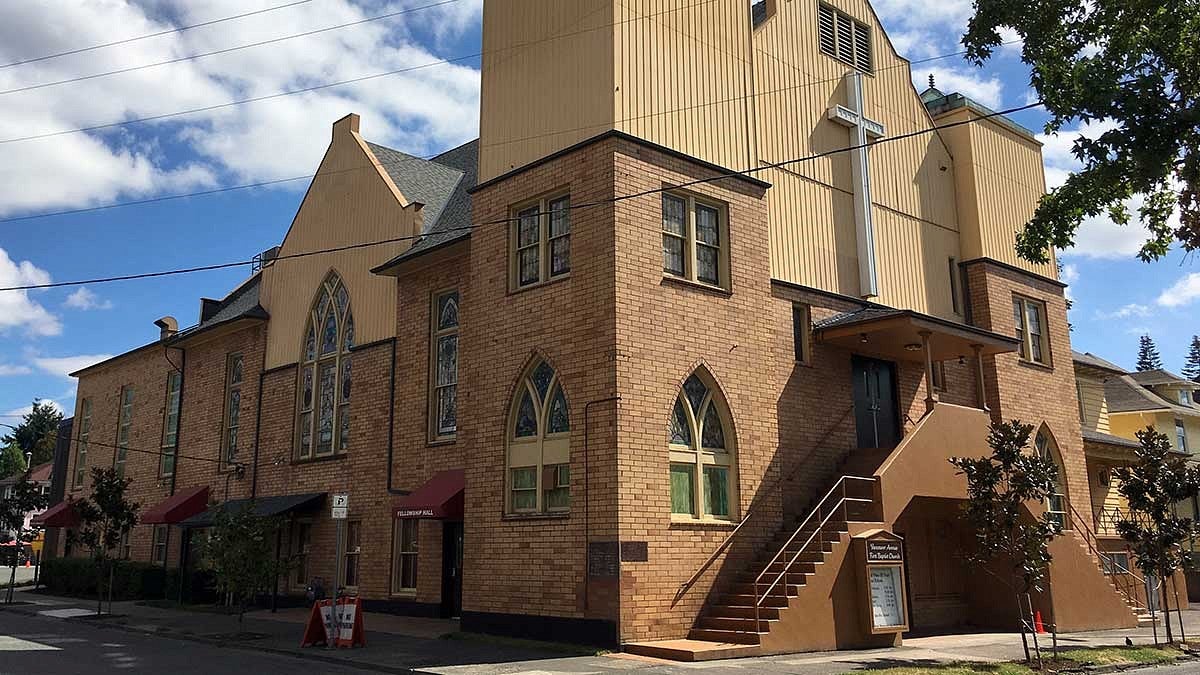
Wallace Sanders' Story

Wallace Sanders doesn’t get up when the residents of Vanport are asked to gather for a group photo inside the Vancouver Avenue First Baptist Church, although he was a seven-year-old boy when he ran through the streets of Vanport yelling, “Run! Everybody run! The water’s coming!” and should be in the photo.
He ran home and found his grandmother, who waved down a city bus. “I’ll tell you what the bus driver said,” Wallace continues. “‘Get on at your own risk. Because my family lives on Lake Street, and I’m going to get my family.’ We didn’t get on the bus; we started to walk up on the bank.”
“So let me tell you something about those 13 people,” he says adamantly, talking about the death toll with a clear, strong voice. “My grandfather stayed down here and worked on the clean-up crew. And he would come home at night crying like a baby. Because for three nights in a row, he said they unloaded three city busses full of people who had drowned. Some of them hanging out the window, and they were in there, crowded like sardines. And that bus driver — the one who stopped to ask if we wanted to get on the bus? One of them was that bus.”
He pauses, and looks down at his hands. “True story. You’re never going to find anything written about that,” he says, finally looking back up. “It’s more than six hundred, the way he described it. But there’s a lot of stuff about Vanport they didn’t print; they never talked about. They never did.”
